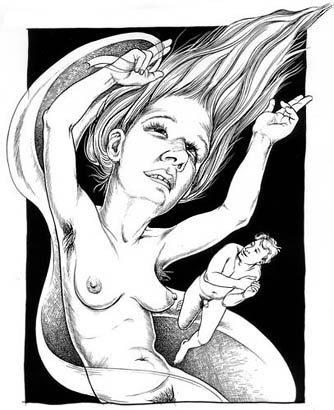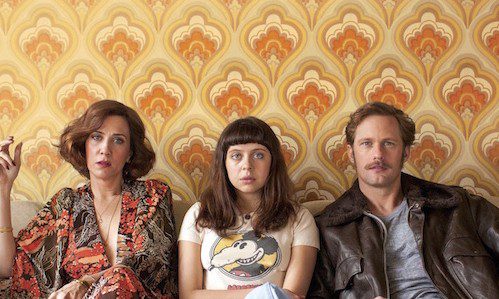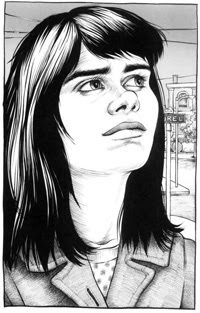How do you write about a film that is getting universal acclaim when you’re mourning the potential of a movie that could have been?
The Diary of a Teenage Girl places me in this curious conundrum. The film is good. Great at moments, even. It’s fun and in some ways it can be seen as a refreshing, if quiet, celebration of female, teenage sexuality and strength. But as Anne Carson has suggested, any kiss can become a “modified blow,” and that is what this film is to me—a peck on the cheek that stings far worse than it caresses. I’m trying to celebrate the film’s impact, much in the same way that I would halfheartedly hug my child after getting a participation ribbon in a race where they clearly didn’t keep up (no one said I was ever going to be a good parent).
What is my issue with the film? Wasn’t the acting good? It was excellent. Wasn’t the story compelling? It was, indeed. Wasn’t the soundtrack catchy? Totally. Toe-tappingly so. As a stand alone, the movie is well done. The problem is the film tells the story of a different teenaged girl than the Minnie found in Phoebe Gloeckner’s graphic novel![cover2015[1]](https://therumpus.net/wp-content/uploads/2015/08/cover20151.png) The Diary of a Teenage Girl, upon which the film was based. And before I get attacked for taking creative license away from directors and writers, please hear me out. I get it. My opinion is subjective. Besides, many films don’t deliver on the promises of the books from which they are adapted. Most don’t, actually. But for me, The Diary of a Teenage Girl matters more than the Twilights or the Harry Potters of this world because Diary had a real chance to do something most films never have a chance to do. Better yet, I would say it had a responsibility to be something better than it was.
The Diary of a Teenage Girl, upon which the film was based. And before I get attacked for taking creative license away from directors and writers, please hear me out. I get it. My opinion is subjective. Besides, many films don’t deliver on the promises of the books from which they are adapted. Most don’t, actually. But for me, The Diary of a Teenage Girl matters more than the Twilights or the Harry Potters of this world because Diary had a real chance to do something most films never have a chance to do. Better yet, I would say it had a responsibility to be something better than it was.
As a film, The Diary of a Teenage Girl is largely about 15-year-old Minnie Goetze’s negotiations of family and first love in San Francisco, 1976. Minnie is maturely immature. Many film critics have even described her as a precocious, smart kid, who reads edgy comic books, swears a lot, and sketches her way into understanding what’s happening inside of her head and to her body. Her drawings come to life at times, providing us a blended smoothie of reality and the wet-dream-like-coma that can sometimes mark adolescence. Like many teenage girls, Minnie is confused about the point of it all. Her home life isn’t Full House. Her young mother has her own needs and insecurities. Her younger sister is intrusive, wanting to know Minnie’s every secret, and her father is gone. Minnie’s stepfather sends psychoanalytic advice and money but is not around, physically. In a moment before body positive feminism, Minnie feels fat and ugly most of the time and she isn’t reassured daily that she’s not. She hates school, is bullied by the Brittanys, Whitneys, and Tiffanys of the world, and boys her own age are terrified of her. A hopeless romantic who refuses the mediocre, Minnie dreams about finding a lover so obsessed with her that they would happily die choking on her last word. Perhaps to this end, she embarks on a whirlwind affair with her mother’s 35-year-old boyfriend Monroe, a point not so much meant to shock us as filmgoers as entertain us. I sound disappointed, right?
I came across Gloeckner’s The Diary of a Teenage Girl at a point in my life when I needed a point to my life. Growing up where I did, on the smallest of islands, there wasn’t much of a plot line for us girls. No matter where you went to school, or who you hung around with at lunch, your inevitable life story always ended up like this: Boy meets girl. Girl loves boy no matter what boy says, drinks, or does. Boy marries girl after the prom. Girl has 1-4 children and becomes a stay-at-home mom, teacher, nurse, or combination of all three. But Diary gave girls like me more room for development. It also gave me permission to like myself. Truth is, I was stuck. And much like Little Minnie, the protagonist (un)loosely based on Gloeckner’s own teenaged experiences, I really needed an honest portrayal of how being a queer, teenage girl actually felt. Society knew very little about girls, but Gloeckner certainly did.  Through graphics and punchy diary entries, she spoke the unspeakable, and her cartoons of angry vaginas, strange penises, women with sharp, pointy breasts, dinosaurs, and random events welcomed me into a world where childhood experiences with sex and sexuality weren’t silenced. Instead, they were truthfully rendered. Together, Minnie and I shared three basic secrets:
Through graphics and punchy diary entries, she spoke the unspeakable, and her cartoons of angry vaginas, strange penises, women with sharp, pointy breasts, dinosaurs, and random events welcomed me into a world where childhood experiences with sex and sexuality weren’t silenced. Instead, they were truthfully rendered. Together, Minnie and I shared three basic secrets:
- The loneliness of growing up with a troubled, young mom was absolute.
- Intergenerational relationships could create more than just victims.
- Sexuality had everything, and nothing at all, to do with happiness.
I knew then that this book would never become a movie. Of that, I was sure. It was too risky and controversial to be released in a freshly post-9/11 world that had just told David Letterman that he wasn’t allowed to joke about September 11th, and a fearful nation that the best way to stay happy in the face of terror was to shop more. Teen narratives were centred around movies about ya-ya sisterhoods, making it as a pop singer, or a princess’s diaries. There was no room for a Little Minnie.
The movie and the graphic novel each center around a young girl who feels trapped by societal expectations that she be happy, and, as a condition of that happiness, normal. The problem is, Minnie has no idea what that means. The pressure to be happy is all over her, and she goes about trying to negotiate relationships with men, lovers, and her mom using the idyllic idea of happiness that she’s been fed by those she cares for. Pascal, her stepfather, tells Minnie happiness can be found through an expensive education. Her mother thinks it lies in Minnie’s sexual prowess. Monroe assures her it will come to her only after he owns a successful business and a boat. From these people, Minnie learns that happiness is found in perfection, prosperity, and power. This logic also informs her understanding of love. For Minnie, there can only be love, or hatred, happiness or its opposite (in Minnie’s estimation), loneliness. Afraid of being alone, she convinces herself that she will possess normalcy through sex, and that sex is somehow, even if tenuously, the key to an unlonely life. To be sure, the main antagonist in Minnie’s life is this pressure to be happy, and it’s only when her loved ones can’t live up to the picture of happiness they’ve painted for her, that she begins to unravel.
Unfortunately, Marielle Heller’s conclusions about happiness are in direct conflict with Gloeckner’s. Heller’s film has a built-in sunniness to it, from its bubblegum-dreams soundtrack (featuring Heart’s “Dreamboat Annie,” and Nate Heller’s “Dreamsong”) to its choices for actors: Kristen Wiig as Minnie’s very forgivable mother-figure; True Blood heartthrob Alexander Skarsgård, as the youngest and hottest looking statutory rapist the world could fathom; even the character of Tabatha, perhaps the most complicated of Minnie’s sexual relationships, is delivered to us by the curly-haired cherub Margarita Levieva, who is nothing like the rough and tumble spill of Tabatha in the original.  Bel Powley, however, is incredible as Minnie. Of that there is no doubt in my mind. But she is only able to deliver us the Minnie scripted for her by Heller, a Minnie stuck in a stasis of waiting to be an adult, but depicted in the film as a wayward child. Heller’s Minnie is a bystander in her own life. The world happens to her. She is obsessed with sex only because of her mother’s belief that feminine sexuality is power. She gets into drugs only because of her monstrous friends and mom. Minnie’s round-eyed naiveté enables us to believe that she has an affair with an older man only because that man fails (as the adult) to stop it from happening. Minnie is a safe character whose melodramatic dalliances are completely forgivable because she is still a little girl suffering predictable blips along the path to normal adulthood. She has no agency of her own, and because of that, her search for happiness becomes the search for someone to tell her what that is.
Bel Powley, however, is incredible as Minnie. Of that there is no doubt in my mind. But she is only able to deliver us the Minnie scripted for her by Heller, a Minnie stuck in a stasis of waiting to be an adult, but depicted in the film as a wayward child. Heller’s Minnie is a bystander in her own life. The world happens to her. She is obsessed with sex only because of her mother’s belief that feminine sexuality is power. She gets into drugs only because of her monstrous friends and mom. Minnie’s round-eyed naiveté enables us to believe that she has an affair with an older man only because that man fails (as the adult) to stop it from happening. Minnie is a safe character whose melodramatic dalliances are completely forgivable because she is still a little girl suffering predictable blips along the path to normal adulthood. She has no agency of her own, and because of that, her search for happiness becomes the search for someone to tell her what that is.
After finishing Gloeckner’s graphic novel you have little doubt that Minnie happens to the world. In stark contrast to the film’s version of the teenaged girl, Gloeckner presents us with the figure of a young girl who is deliberate in her actions, and much more intelligent than our notion of teenage whimsy allows. At times, Gloeckner’s Minnie is difficult to like. She gives her reader pause because she makes us uncomfortable, and in many ways she’s a failure—she fails at being the nice girl we as a society have come to want. She is lonely. She is suicidal. She is alienated and bullied, excluded at school by her peers because she is read as threatening and disgusting. She writes bad poetry about her own death, and discusses it happening so much it becomes a broken record. She’s miserable. This enables a more complicated understanding of girls that doesn’t presume victimization or magical ponies at every turn. It also doesn’t presume innocence. Instead, Minnie prepares readers for the fact that young people are bright, cunning, sexual, and fallible, and that growing up is a journey of constant, unhappy fuck-ups. And that that is normal.
Being a teenager sucks. It’s not pretty or nice or sweet or kind. It’s bitter and sometimes jealous; it’s pimply, bloated, bloody, and stinky; it’s uncertain and self-loathing; it’s unhappy and unsure, and it’s definitely lonely at times. But teens are constantly burdened by our adult expectations of their development. They are expected to grow up, even out, buck up, and become someone else. Maybe it’s because of these expectations that happiness gets used as a profiling tool at schools, in families, and on the streets. We presume to know what makes for a normal person, and we tell unhappy people that in order to belong and be accepted they need to get happier. But happiness, in the ways in which it is being marketed to young people, is not accessible to everyone. It’s a privileged emotion meant for few, and being left out can feel dire.
 The failure of the film is that it takes the unsettled feelings of being a teen and gift wraps them with smiles. It robs us of the potential that Minnie does not see her happy ending. By the film’s end, Minnie has been healed through family reconciliation, an encouraging note from her famous mentor, and a return to childhood innocence. Her mother tells her they can be friends again, but that no one wants to hear her sad stories anymore. She and her sister skip off arm in arm on a beach. The best feature of Gloeckner’s The Diary is its honest ending. Minnie looks around at her life and sees a lot of sadness under the guise of well-being. It makes her wonder what will make her happy. Marriage? Being slim and pretty? Owning a house, having a sister, a job, a boyfriend? Money and friends, a car? Two cars? A perfect mom? The world around her says yes, but Minnie knows that this answer doesn’t ring true for her. The graphic novel permits Minnie’s uncertainty about happiness to be lived as an ordinary, everyday feeling without cause for a panicked visit to a psychiatrist, or fear that suicide is right around the corner. Minnie is allowed to be the girl who doesn’t make up with her mother at the end; the girl who might grow up to be a troubled person; the girl who doesn’t leave the party before she is sold to a group of men for sex by her girlfriend; the girl who you might not want babysitting your kids, or dating your sons and daughters. Instead of being happy, at the end of the narrative Gloeckner’s Minnie settles for being “not sad all the time.”
The failure of the film is that it takes the unsettled feelings of being a teen and gift wraps them with smiles. It robs us of the potential that Minnie does not see her happy ending. By the film’s end, Minnie has been healed through family reconciliation, an encouraging note from her famous mentor, and a return to childhood innocence. Her mother tells her they can be friends again, but that no one wants to hear her sad stories anymore. She and her sister skip off arm in arm on a beach. The best feature of Gloeckner’s The Diary is its honest ending. Minnie looks around at her life and sees a lot of sadness under the guise of well-being. It makes her wonder what will make her happy. Marriage? Being slim and pretty? Owning a house, having a sister, a job, a boyfriend? Money and friends, a car? Two cars? A perfect mom? The world around her says yes, but Minnie knows that this answer doesn’t ring true for her. The graphic novel permits Minnie’s uncertainty about happiness to be lived as an ordinary, everyday feeling without cause for a panicked visit to a psychiatrist, or fear that suicide is right around the corner. Minnie is allowed to be the girl who doesn’t make up with her mother at the end; the girl who might grow up to be a troubled person; the girl who doesn’t leave the party before she is sold to a group of men for sex by her girlfriend; the girl who you might not want babysitting your kids, or dating your sons and daughters. Instead of being happy, at the end of the narrative Gloeckner’s Minnie settles for being “not sad all the time.”
Why is this a better ending? It makes room for Minnie to live and make mistakes, and recognize that in the world we live in, sometimes situations, people, and circumstances don’t magically get better for the sake of everyone else’s peace of mind. Minnie gets to be celebrated as the girl with ugly feelings and thoughts who refuses to see a blanket happiness as her limit. Her unhappiness serves as a plea to listen to what teenagers are thinking and feeling everyday. Her story unsettles the cheerful directives implicit in the way we raise our teenagers, and allows a space for lonely, unhappy kids to play too. Gloeckner has stated that if she had have done the film version of The Diary herself, “it would have been a film that would hurt to watch.” Heller has done the opposite; she has given us a film that is supposed to be about a girl’s relationship with herself and the world, and instead gives us an endearing comedy about a girl living in a quirky family. It doesn’t make you ache. Perhaps it couldn’t. If Monroe had have been portrayed as he was in the graphic novel, as a grown man with beer-pudge around his gut, who looked aged and hairy in all of the places hair grows, could we have stomached watching his and Minnie’s sex scenes? Could we have been turned on? If Minnie’s mother had have continued to ignore her daughter’s cries for help, or abandoned her to herself would the film have done well? Maybe the film wouldn’t have been produced. Minnie would have been seen as the victim of abuse and neglect, and that would have been uncomfortable to watch. But it would have been more honest.
***
Image credits: featured image, image #3, image #4, image #5.




